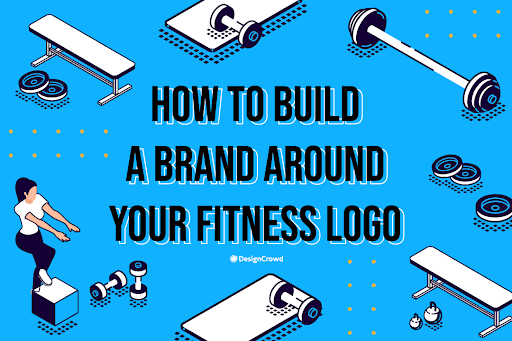We’ve all seen it: the same old fitness logo. Whether it’s an eagle, a barbell, or some other generic symbol, these logos are so overused that they make you want to skip leg day altogether. If you want your brand to stand out from the crowd, then you need something more meaningful than a cliche symbol.
Here are some steps for creating a strong fitness logo—one that people will remember and connect with!
Keep it Simple
Simplicity is the key to a great logo. You don’t have to be a graphic designer, but you should know how to make something look good. If you can’t design your own logo, hire someone who knows what they’re doing.
The best logos are simple, clean, and easy to read from across the room (and from a distance). They use a minimal amount of colors and fonts that are easy on the eyes and don’t distract from your brand name or message.
In short: Keep it simple!
Make Your Logo Memorable
You want to make sure your logo is memorable, so one way to do that is by making it unique.
You can also make sure that your logo is memorable by making it unique.
In fact, there are many different ways to go about this!
The best way (in our opinion) would be to create something that’s both unique and memorable—but there are other options too!
Use Meaningful Colors in your Logo
The color you use should be relevant to the brand and message of your company.
For example, if a fitness company is targeting people who want to get fit, it would make sense for them to use green as their main color. Green is associated with health, wealth, and prosperity. It’s also a masculine color so it’s appropriate for a male audience. If a fitness brand was targeting females instead of males then it might be more appropriate for them to use pink or purple as their main color because these are feminine colors that can help attract women into their gym or club respectively.
Equality and Balance
There is a mathematical formula called the golden ratio that can help you create a visually pleasing logo. The golden ratio was discovered by ancient Greeks, and it’s an aesthetic theory that has been used for centuries to create harmonious designs. The formula is 1:1.618, which means one part of your design should be equal in size to 1.618 parts of another part of the design (or any multiple thereof).
For example, let’s say your logo needs three parts: the text, the graphic element on top of it, and its border around it. If each of these three elements is represented as one part in our graphical equation above (1:1), then this tells us we need a fourth element—the space between them all—to equal 0.618 (2/3) times their total surface area combined!
You could use this same technique with any number of elements or layers within a single piece of art or graphic design but keep in mind that some numbers work better than others depending on how many things are being arranged together into one cohesive unit such as five versus seven or nine versus eleven vs thirteen vs fifteen vs seventeen etc.
Make Sure It Makes an Impact
The next step to building a strong fitness logo is ensuring that it makes an impact. A memorable, unique, and easy-to-read logo will help you stand out from the competition, especially if you’re working on a tight budget. It’s important to consider how users perceive your brand before deciding on a design; if you’re trying to build trust with potential customers, for example, your logo should look professional and trustworthy. If you want people to see your business as fun and relatable (or even edgy), then go for something with character.
Avoid Generic Symbols
Generic symbols like a heart, an arrow, or a star are usually overused and don’t do much to help your brand stand out. If you want to use a symbol in your logo design, make sure that it’s unique to your brand and has meaning behind it.
Here are some examples of generic symbols:
- Heart
- Arrow pointing up
- Star
Think About Typography
Typography is an important part of your logo. In fact, it’s arguably more important than the actual logo itself. So much so that if you don’t have a great font, nothing else matters.
For example, if your brand’s personality is edgy and bold, then a simple sans serif font like Arial or Helvetica might work best for you. However, if your brand has a softer and more traditional feel to it (think: yoga studio), then something like Bodoni may be better suited for this type of business.
Make sure the typeface matches both the personality of your business as well as its purpose (e.g., fitness). If you’re designing a logo for an activewear company that sells gym clothing and accessories online—and wants customers who appreciate high-tech products—you won’t want to choose something with serifs because those will make it harder for consumers to read when scaled down on their computer screens; instead, opt for sans serif fonts such as Helvetica Neue Light which provides better readability at small sizes while still remaining unique enough not to be confused with similar looking brands using different fonts altogether!
Use Contrast
Contrast plays an important role in logo design. It is the use of two or more colors that are different from each other to create a visual impact. Contrast is an important part of your logo as it helps to draw attention and make the logo stand out from its competitors.
Here are some tips on how to use contrast effectively:
- Use contrasting colors in your logo. Colors like red and green stand out against each other, while blue and orange create an energetic feel. These combinations may not be easy on the eyes, but they will certainly grab people’s attention!
- Include images with high contrast in your design if you want it remembered easily by potential customers who see it online or off-line (in print). For example, using black text on a white background will ensure people notice what you’re trying to show them quickly without straining their eyes too much at first glance; however, this might not necessarily mean they’ll remember all those details later on down road when making buying decisions so keep that in mind as well as things like “does this look professional” etc.
Avoid Overused Fitness Logos
The next step to creating a logo that’s uniquely yours is avoiding the overused, common fitness logos that are often seen on gym walls and in ads. These include:
- A pair of hands with thumbs up
- An outline of an exercise machine like a dumbbell or elliptical machine
- A human figure doing an exercise (like push-ups)
Use logo websites!
We all know how important it is to build a strong fitness brand, but how can you go about putting together a fitness logo that’s going to represent your brand in the best way possible? Well, there are many ways and options for building a strong fitness logo.
One of the best things about Designhill is that it gives you a chance to see what other people have created before you. In addition, it gives you an opportunity to get inspired by their designs and be creative yourself!
Here are some tips on how to use Designhill:
* When you are on the Designhill website, click on the logo design gallery and find something that inspires you. If there is a design that suits your personality or business needs, then go ahead and purchase it! Just be sure not to use any images from other websites without their permission first.
* Check out the logo design trends. This is a great way to see what people are creating these days! Get inspired by these designs, and you may come up with something amazing yourself!
Apart from this if you are interested to know more about The Top 6 Advantages of Franchising Your Business then visit our SMALL BUSINESSES category.








